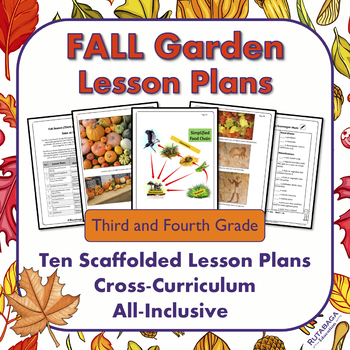Fall Garden Lesson Plans and Activities - Third and Fourth Grade - Ten Weeks
- PDF
Description
Kids will love these FALL Garden-based Science, Nature, and Nutrition Lessons written for Third and Fourth Grade children (activities are also appropriate to use with older kids as well).
The Third and Fourth Grade Fall Lessons explore planting and harvesting what is seasonally appropriate, and children explore the history of growing food worldwide. Life Science is also a key theme in examining how all components work together to create a healthy garden ecosystem.
Resource Highlights:
- 10 scaffolded easy to teach lessons that build upon themselves from week to week
- Cross-curriculum content that brings real-life relevance to other subject areas
- All-inclusive photos and resources provided, which means less prep time and more time learning outdoors (printable pages for kids are also included)
- Each week has a 3-4 page scripted lesson so that teachers and parents can lead with confidence
Topic Covered Include:
- Seasonal Planting and Planning (Warm versus Cool Seasons)
- Cucumbers (Nutrition, History, and Preservation)
- Earth as an Apple (Environmental Activity and Discussion, along with Apple Info.)
- Pumpkins (Observation and Math Estimation and Multiplication)
- Leaves Changing Color (Chlorophyll and Photosynthesis and History)
- Worms (Anatomy, Decomposition, Composting)
- Soil (Healthy Composition and Acidity Levels)
- Potatoes (History, How to Grow, Recipes)
- Fall Scavenger Hunt (Measurement, Observation, Food Chains)
- Fall Harvest (When and How)
This is a tested elementary school curriculum that makes it easy to have or add garden-based learning to any classroom or home. Kids will not feel like they are doing any "work" while engaging with their environment. Learning about where our food comes from encourages community, collaboration, environmental awareness, and life-long healthy habits.
Having a garden plot is helpful, but not needed for these lessons to be impactful!
Please do not forget that leaving a review earns you points toward FREE TpT purchases. I love and appreciate the feedback!
Also, follow me and be notified when new products are uploaded. I have many easy-to-teach and engaging resources I plan to share on this platform within the next month!
I love what I do, and providing "hands-on" learning for a variety of learners is my passion.
Please contact me with any questions!
Thank you very much,
Kaitlin Mitchell





